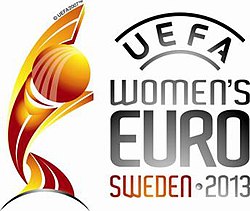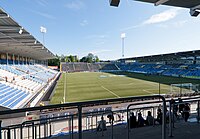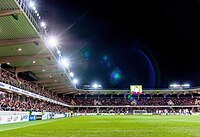The 2013 UEFA Women's Championship, commonly referred to as Women's Euro 2013, was the 11th European Championship for women's national football teams organised by UEFA. The final tournament, held in Sweden from 10 to 28 July 2013,[2] became the most-watched in the history of the Women's Euros.[3] It concluded with Germany, the defending champions, winning their sixth consecutive and eighth overall Women's Euro title after defeating Norway in the final.[4]
| Europamästerskapet i fotboll för damer 2013 | |
|---|---|
 | |
| Tournament details | |
| Host country | Sweden |
| Dates | 10–28 July |
| Teams | 12 |
| Venue(s) | 7 (in 7 host cities) |
| Final positions | |
| Champions | |
| Runners-up | |
| Tournament statistics | |
| Matches played | 25 |
| Goals scored | 56 (2.24 per match) |
| Attendance | 216,888 (8,676 per match) |
| Top scorer(s) | |
| Best player(s) | |
Sweden were selected as hosts by UEFA's Executive Committee in 2010, meaning their team automatically qualified for the final tournament. The other eleven finalists were decided by a qualifying competition, featuring 44 teams, staged between March 2011 to October 2012. It was the last time the finals featured twelve teams, as from 2017 onwards they would be expanded to include sixteen teams.[5]
Host selection
editSweden was awarded the hosting of the tournament on 4 October 2010 at a meeting of the UEFA Executive Committee in Minsk, Belarus.[6] The only rival host bid came from the Netherlands.[6] Several other European national associations, including Switzerland, Bulgaria and Poland, had shown interest in staging the tournament but did not submit final applications.[7] Sweden had previously co-hosted the tournament in 1997.[8]
Qualification
editA total of 44 teams entered the qualification process to compete for the eleven available places in the final tournament, alongside host nation Sweden, who qualified automatically. Six teams were firstly eliminated during an eight-team preliminary round staged in Macedonia and Malta on 3–8 March 2011.[9]
On 14 March 2011 38 teams – the 36 top-ranked nations (according to their UEFA coefficient) and the two teams advancing from the preliminary round – were then drawn into seven qualifying groups at a draw in Nyon, Switzerland.[10] Matches in these qualifying groups began in September 2011 and concluded a year later.[10] The seven group winners automatically qualified for the final tournament along with the best-ranked runners-up.[11] The remaining six runners-up entered into two-legged play-offs held in October 2012 to determine the final line-up.[12] The following twelve teams participated in the final tournament:
| Team | Method of qualification | Date of qualification | Finals appearance | Last appearance | Previous best performance | FIFA ranking at start of event |
|---|---|---|---|---|---|---|
 Sweden Sweden | Hosts | 4 October 2010 | 9th | 2009 | Champions (1984) | 5 |
 Italy Italy | Group 1 winner | 16 June 2012 | 10th | 2009 | Runners-up (1993, 1997) | 12 |
 Germany Germany | Group 2 winner | 16 June 2012 | 9th | 2009 | Champions (1989, 1991, 1995, 1997, 2001, 2005, 2009) | 2 |
 Norway Norway | Group 3 winner | 19 September 2012 | 10th | 2009 | Champions (1987, 1993) | 11 |
 France France | Group 4 winner | 15 September 2012 | 5th | 2009 | Quarter-finals (2009) | 6 |
 Finland Finland | Group 5 winner | 15 September 2012 | 3rd | 2009 | Semi-finals (2005) | 21 |
 England England | Group 6 winner | 19 September 2012 | 7th | 2009 | Runners-up (1984, 2009) | 7 |
 Denmark Denmark | Group 7 winner | 19 September 2012 | 8th | 2009 | Semi-finals (1984, 1991, 1993, 2001) | 13 |
 Netherlands Netherlands | Best runner-up | 19 September 2012 | 2nd | 2009 | Semi-finals (2009) | 14 |
 Spain Spain | Play-off winner | 24 October 2012 | 2nd | 1997 | Semi-finals (1997) | 18 |
 Russia Russia | Play-off winner | 25 October 2012 | 4th | 2009 | Group Stage (1997, 2001, 2009) | 22 |
 Iceland Iceland | Play-off winner | 25 October 2012 | 2nd | 2009 | Group Stage (2009) | 15 |
Venues
editThe tournament was staged at seven venues in seven different towns with each group being staged at two different venues. At some venues, the capacity was reduced during the championship.[13]
| Gothenburg | Solna | Norrköping |
|---|---|---|
| Gamla Ullevi | Friends Arena | Nya Parken |
| Capacity: 16,600 | Capacity: 50,000 | Capacity: 10,500 |
| 3 group matches, 1 semi-final | Final | 3 group matches, 1 semi-final |
 |  |  |
| Linköping | UEFA Women's Euro 2013 (Southern Sweden) | Kalmar |
| Linköping Arena | Guldfågeln Arena | |
| Capacity: 7,300 | Capacity: 10,900 | |
| 3 group matches, 1 quarter-final | 3 group matches, 1 quarter-final | |
 |  | |
| Halmstad | Växjö | |
| Örjans Vall | Myresjöhus Arena | |
| Capacity: 7,500 | Capacity: 10,000 | |
| 3 group matches, 1 quarter-final | 3 group matches, 1 quarter-final | |
 |  |
Final draw
editThe final draw for the tournament group stage took place on 9 November 2012 at the Swedish Exhibition & Congress Centre in Gothenburg.[14][15] The ceremony was conducted by the UEFA General Secretary Gianni Infantino, with the teams drawn out by tournament ambassadors Patrik Andersson and Steffi Jones.[14]
As hosts, Sweden were automatically placed in the top-seeded pot, though they would have been in any case owing to their UEFA coefficient ranking.[14][16] The eleven qualifiers were placed into the three final draw pots according to their UEFA coefficient ranking.[14] It was decreed in advance the groups into which the three top-seeded teams would be placed.[14]
Seedings
editMatch officials
editTwelve referee trios were announced by the UEFA on 19 June 2013.[17] All officials were based in Jönköping.
 Kirsi Heikkinen (Finland)
Kirsi Heikkinen (Finland) Bibiana Steinhaus (Germany)
Bibiana Steinhaus (Germany) Katalin Kulcsár (Hungary)
Katalin Kulcsár (Hungary) Silvia Spinelli (Italy)
Silvia Spinelli (Italy) Teodora Albon (Romania)
Teodora Albon (Romania) Cristina Dorcioman (Romania)
Cristina Dorcioman (Romania) Jenny Palmqvist (Sweden)
Jenny Palmqvist (Sweden) Esther Staubli (Switzerland)
Esther Staubli (Switzerland) Kateryna Monzul (Ukraine)
Kateryna Monzul (Ukraine)
 Lucie Ratajová (Czech Republic)
Lucie Ratajová (Czech Republic) Sian Massey (England)
Sian Massey (England) Tonja Paavola (Finland)
Tonja Paavola (Finland) Marina Wozniak (Germany)
Marina Wozniak (Germany) Judit Kulcsár (Hungary)
Judit Kulcsár (Hungary) Romina Santuari (Italy)
Romina Santuari (Italy) Hege Steinlund (Norway)
Hege Steinlund (Norway) Petruţa Iugulescu (Romania)
Petruţa Iugulescu (Romania) Maria Lisická (Slovakia)
Maria Lisická (Slovakia) Maria Villa Gutiérrez (Spain)
Maria Villa Gutiérrez (Spain) Helen Karo (Sweden)
Helen Karo (Sweden) Natalia Rachynska (Ukraine)
Natalia Rachynska (Ukraine)
 Carina Vitulano (Italy)
Carina Vitulano (Italy) Esther Azzopardi (Malta)
Esther Azzopardi (Malta) Monika Mularczyk (Poland)
Monika Mularczyk (Poland)
Squads
editThe twelve national teams involved in the tournament were required to register a squad of 23 players by 3 June 2013 at the latest.[18] Only players in these squads were eligible to take part in the tournament.
Results
edit
The final match schedule for the tournament was confirmed on 6 December 2012.[19] All twelve finalists began the tournament at the group stage, with those not eliminated then advancing to the knockout stage.
Group stage
editThe group winners and runners-up would qualify for the knockout stage, along with the best two third-placed teams; the remaining four teams would be eliminated.
- Tie-breaking criteria
If two or more teams were equal on points on completion of the group matches, the following tie-breaking criteria were applied:[20]
- Higher number of points obtained in the matches played between the teams in question;
- Superior goal difference resulting from the matches played between the teams in question;
- Higher number of goals scored in the matches played between the teams in question;[a]
- Superior goal difference in all group matches;
- Higher number of goals scored in all group matches;
- If two teams tie (following the application of tiebreakers 1–5) after having met in their final fixture of the group stage, then their ranking will be determined by penalty shoot-out;[b]
- Position in the UEFA national team coefficient ranking system as at the final draw;
| Team qualified for the knockout stage |
Group A
edit| Team | Pld | W | D | L | GF | GA | GD | Pts |
|---|---|---|---|---|---|---|---|---|
 Sweden Sweden | 3 | 2 | 1 | 0 | 9 | 2 | +7 | 7 |
 Italy Italy | 3 | 1 | 1 | 1 | 3 | 4 | −1 | 4 |
 Denmark Denmark | 3 | 0 | 2 | 1 | 3 | 4 | −1 | 2 |
 Finland Finland | 3 | 0 | 2 | 1 | 1 | 6 | −5 | 2 |
Group B
edit| Team | Pld | W | D | L | GF | GA | GD | Pts |
|---|---|---|---|---|---|---|---|---|
 Norway Norway | 3 | 2 | 1 | 0 | 3 | 1 | +2 | 7 |
 Germany Germany | 3 | 1 | 1 | 1 | 3 | 1 | +2 | 4 |
 Iceland Iceland | 3 | 1 | 1 | 1 | 2 | 4 | −2 | 4 |
 Netherlands Netherlands | 3 | 0 | 1 | 2 | 0 | 2 | −2 | 1 |
Norway  | 1–0 |  Netherlands Netherlands |
|---|---|---|
Gulbrandsen  54' 54' | Report |
Iceland  | 0–3 |  Germany Germany |
|---|---|---|
| Report | Lotzen  24' 24'Okoyino da Mbabi  55', 84' 55', 84' |
Group C
edit| Team | Pld | W | D | L | GF | GA | GD | Pts |
|---|---|---|---|---|---|---|---|---|
 France France | 3 | 3 | 0 | 0 | 7 | 1 | +6 | 9 |
 Spain Spain | 3 | 1 | 1 | 1 | 4 | 4 | 0 | 4 |
 Russia Russia | 3 | 0 | 2 | 1 | 3 | 5 | −2 | 2 |
 England England | 3 | 0 | 1 | 2 | 3 | 7 | −4 | 1 |
Ranking of third-placed teams
editThe best two third-placed teams advanced to the knockout stage, with teams being ranked using points as the only criterion.[21] UEFA introduced this principle to avoid teams entering their final matches and "playing on" the previous results, and also to negate the factor of the potentially different strengths of the groups by eliminating goal difference from the calculation.[21] As both Denmark and Russia finished with two points, in accordance with the regulations,[21] UEFA conducted a drawing of lots on 18 July following the completion of the group matches to determine which of these two teams would advance: Denmark was selected and so advanced.[22]
| Group | Team | Pld | Pts | Drawing of lots |
|---|---|---|---|---|
| B |  Iceland Iceland | 3 | 4 | – |
| A |  Denmark Denmark | 3 | 2 | won |
| C |  Russia Russia | 3 | 2 | lost |
Knockout stage
editThe eight advancing teams entered the knockout stage to compete in a single-elimination style tournament. In the knockout stage (including the final), if a match was level at the end of 90 minutes, extra time of two periods (15 minutes each) was played. If the score was still level after extra time, the match was decided by a penalty shootout.[23]
| Quarter-finals | Semi-finals | Final | ||||||||
| 21 July – Halmstad | ||||||||||
 Sweden Sweden | 4 | |||||||||
| 24 July – Gothenburg | ||||||||||
 Iceland Iceland | 0 | |||||||||
 Sweden Sweden | 0 | |||||||||
| 21 July – Växjö | ||||||||||
 Germany Germany | 1 | |||||||||
 Italy Italy | 0 | |||||||||
| 28 July – Solna (details) | ||||||||||
 Germany Germany | 1 | |||||||||
 Germany Germany | 1 | |||||||||
| 22 July – Kalmar | ||||||||||
 Norway Norway | 0 | |||||||||
 Norway Norway | 3 | |||||||||
| 25 July – Norrköping | ||||||||||
 Spain Spain | 1 | |||||||||
 Norway (pen.) Norway (pen.) | 1 (4) | |||||||||
| 22 July – Linköping | ||||||||||
 Denmark Denmark | 1 (2) | |||||||||
 France France | 1 (2) | |||||||||
 Denmark (pen.) Denmark (pen.) | 1 (4) | |||||||||
All times are local (UTC+2)
Quarter-finals
editFrance  | 1–1 (a.e.t.) |  Denmark Denmark |
|---|---|---|
Nécib  71' (pen.) 71' (pen.) | Report | Rasmussen  28' 28' |
| Penalties | ||
Nécib  Thiney  Le Sommer  Delannoy  | 2–4 |  Røddik Røddik Rydahl Rydahl Nadim Nadim Nielsen Nielsen Arnth Arnth |
Semi-finals
editNorway  | 1–1 (a.e.t.) |  Denmark Denmark |
|---|---|---|
Christensen  3' 3' | Report | Knudsen  87' 87' |
| Penalties | ||
Gulbrandsen  Dekkerhus  Mjelde  Rønning  | 4–2 |  Røddik Røddik Nielsen Nielsen Nadim Nadim Brogaard Brogaard |
Final
editStatistics
editGoalscorers
edit- 5 goals
- 3 goals
- 2 goals
- 1 goal
 Johanna Rasmussen
Johanna Rasmussen Eniola Aluko
Eniola Aluko Laura Bassett
Laura Bassett Toni Duggan
Toni Duggan Annica Sjölund
Annica Sjölund Simone Laudehr
Simone Laudehr Lena Lotzen
Lena Lotzen Dzsenifer Marozsán
Dzsenifer Marozsán Anja Mittag
Anja Mittag Dagný Brynjarsdóttir
Dagný Brynjarsdóttir Margrét Lára Viðarsdóttir
Margrét Lára Viðarsdóttir Ilaria Mauro
Ilaria Mauro Marit Fiane Christensen
Marit Fiane Christensen Ada Hegerberg
Ada Hegerberg Kristine Wigdahl Hegland
Kristine Wigdahl Hegland Ingvild Isaksen
Ingvild Isaksen Nelli Korovkina
Nelli Korovkina Elena Morozova
Elena Morozova Elena Terekhova
Elena Terekhova Alexia Putellas
Alexia Putellas Kosovare Asllani
Kosovare Asllani Marie Hammarström
Marie Hammarström
- Own goal
 Raffaella Manieri (playing against Sweden)
Raffaella Manieri (playing against Sweden) Irene Paredes (playing against Norway)
Irene Paredes (playing against Norway)
Awards
edit- UEFA Squad of the Tournament[1]
- Golden Boot[24]
Miscellany
editAnthem
edit
The official anthem of the tournament was "Winning Ground", composed by Stefan Örn and performed by Swedish pop star Eric Saade.[25] The title of the song was also the slogan of the final tournament.[26][25] The song was presented on 27 May 2013 at the Friends Arena in an event also featuring Tyresö players Lisa Dahlkvist of Sweden, Denmark's Line Røddik Hansen, Spain's Verónica Boquete and the Netherlands' Kirsten van de Ven.[25]
Tickets
editTickets for the finals were released on 14 February 2013, available to buy via UEFA's online sales portal or from the Ticnet agency in Sweden.[27] The pricing structure was the same for all venues: SEK 200 (approximately €23.50[c]) for Category 1 matches, SEK 150 (≈€17.60) for Category 2 and SEK 100 (≈€11.75) for Category 3. Youth tickets, for those aged up to 16, cost SEK 50 (≈€5.85) for all categories. A so-named Follow Your Team Ticket which gave entrance to all three group matches of a selected team was also sold.[27]
The tournament soon surpassed the previous ticket sales record of 129,000 set in 2009,[3] which prompted the organisers to open up the entire 50,000 seats of the Friends Arena for the final, in contrast to the original plan to place only 30,000 tickets on sale.[28] The final set a new attendance record for a Women's Euros fixture (41,301) and helped bring the total number of tickets sold for the tournaments to 216,888.[29] In addition to attending the matches, the tournament became the first Women's Euros event to feature fan zones where fans could gather together to view matches on big screens.[30]
References and notes
editExternal links
edit
- No URL found. Please specify a URL here or add one to Wikidata.

- Official technical report









